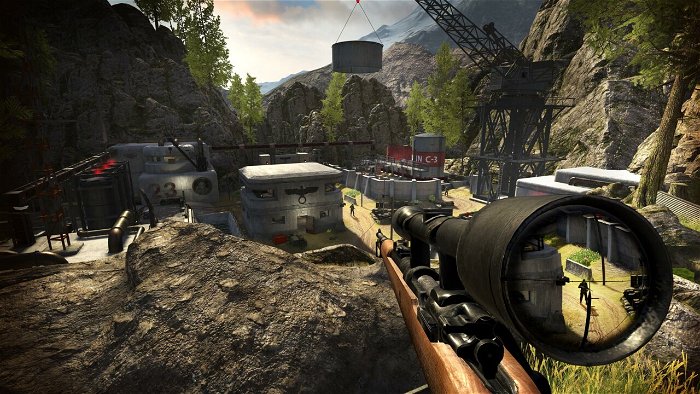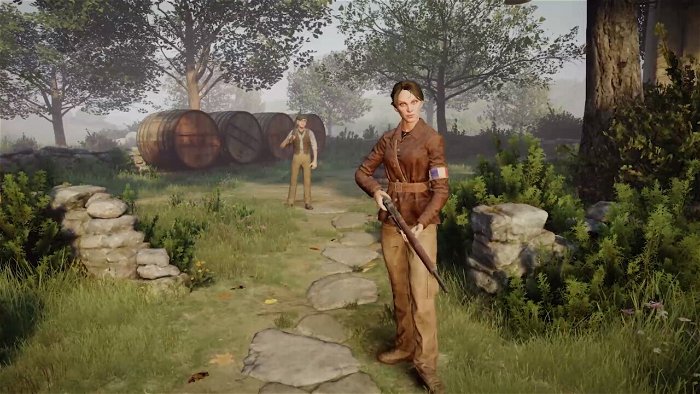The idea of a “AAA” VR game seems exciting. Futurists dream about the combination of VR’s hands-on approach to gaming. That physicality puts us closer to the action, which surrounds us on a life-sized scale. Of course, it’s not exactly like sitting on a couch and staring at a flat 4K screen. Like a concept ripped straight out of The Matrix, VR games are completely driven by our own bodies.
Virtual reality is made even cooler by how obtainable the tech is on store shelves. There’s no telling buyers have expectations out of this special game console. The biggest being VR’s impact for our favourite franchises. But with massive studios having existed through the same console and TV format for decades, the VR leap comes with some trouble. It’s also why killer apps from high budget studios don’t feel the same – if not better as VR would have us expect.
VR should be the best way to enjoy gaming’s most treasured franchises. Not the other way around.

I fell in love with VR for that concept of “being in a video game.” It takes away a passive effect for observing characters with controllers. Instead, VR puts us directly in the world to get the job done. In reality, there’s a chance for developers to invite us. Letting us become our favourite characters in big worlds like Halo, Assassin’s Creed or Grand Theft Auto. Five years after VR exploded into the consumer world, we’re still waiting for those behemoth studios to catch up.
That “AAA” term – in game language – derives from the highest quality product players can get. It’s a grade used by Canadian beef, gems and investment companies. Clearly, there’s a top standard when used interchangeably with just about anything. For games? AAA studios and games have been shaped by their most popular and successful franchises. Industry darlings like PlayStation Studios, Nintendo, Square Enix and Capcom are a few in mind. They’ve also mastered the art of making games for screens. Players are sitting still, doing everything from a controller.
Strangely, this traditional way of game making doesn’t work for VR. It’s not as simple as turning Liberty City, Midgard or Hyrule Castle life-sized. Then letting players run free in worlds they’ve dreamed of being surrounded in. Unfortunately, it’s also that straightforward belief causing VR’s few “AAA” games to suck. As a result, some of VR’s releases from big studios still play horribly. What should have been wish fulfillment results in disappointment from an otherwise qualified studio. Case in point: two successful WW2 franchises touching VR for the first time.
Recent titles including Sniper Elite VR, and Medal of Honor: Above & Beyond are obviously inspired by their console games. Both franchises worked best as console shooters before. But controls make all the difference for bringing a console game to VR spaces. Players might be familiar with how to move, aim and shoot with a similar control scheme. That’s because all traditional games can be mapped to one controller. It’s been like that for years to come, until VR threw a curveball at AAA studios.

There’s a certain level of care which comes with building a VR game. As mentioned, it’s not like dropping players into levels made for consoles. Developers in Sniper Elite VR were able to make a simulated world which wraps players around in 1:1 (life-sized) scale. This obviously means almost every game in VR would be a first person game. Sniper Elite VR certainly has detailed battlefields in WW2 Italy. But the entire shooting experience feels awkward, cluttered and janky. Guns lacked weight and stability. Shots would miss, leading to some clumsy reloads. Nazis would pile on the damage and pressure. VR players accidentally grab a grenade instead of ammo out of their belt.
As excited as I was for Sniper Elite to get that VR treatment, Rebellion Developments’ game didn’t exactly take a real advantage of the platform. Simply put, Sniper Elite was out of its element without consoles. A surprise given Rebellion Developments’ self-made experience as a AAA developer and publisher over the years. This happens more often as it should, when big studios attempt to make dreams come true with VR.
Sniper Elite’s jump to VR missed the standards for comfort and body controls. As per my review, it’s a console experience that should’ve worked better in virtual reality. Luckily, there are standards to tell bad VR experiences from very good ones. But only a few AAA studios have mastered made-for-VR games. Unlike those long-existing studios, smaller developers who’ve built their identities on VR are ahead of the curve. Studios like Survios, Skydance Interactive and ILMxLab are getting to handle AAA franchises where traditional ones can’t.
On the other hand, Medal of Honor: Above and Beyond features some excellent shooter mechanics for VR. AAA studio Respawn Entertainment took a bold step into virtual reality with some background knowledge. Its developers are at their most comfortable across smash hits like Apex Legends, Jedi Fallen Order and the Titanfall series. But entering VR with Medal of Honor somehow broke their hot streak.

Like any good VR game, Above and Beyond respects physics. It’s the one mechanic AAA studios miss when trying to create a virtual reality simulation. Objects can be touched with endless points of contact. Gravity gives weapons and obstacles weight. Player actions require a bit of strength. Guns have moving parts that are easy to use. Sounds a bit like real life, right? That’s because AAA studios are challenged with nailing this extra step in development. A physics system sets VR games apart from traditional console ones. Mainly because controller players aren’t required to be physically moving. Medal of Honor: Above and Beyond still falls short since it wasn’t treated like a normal game. As my counterpart from Road to VR best describes, “It feels very much like the sequences in the game were picked not because they specifically supported fun VR gameplay, but because they checked the box of what someone imagined would be ‘cool to do’ in a WWII VR shooter.”
My 7/10 review for Medal of Honor left room to improve. The game suffers from some god-awful interruptions. Its biggest problem comes from Respawn Entertainment treating development differently than full fledged titles. Levels are broken into bite-sized arcade pieces. Players are soldiering for five minutes before a screen tells you good job. It’s since been removed, but players are still interrupted with the same amount of pauses.
“VR level design shouldn’t be any different for AAA studios, known for creating lengthy missions.”
VR level design shouldn’t be any different for AAA studios, known for creating lengthy missions. In Respawn’s case, Above and Beyond felt arcadey at times. It’s a route new VR devs go for, doling out bite-sized pieces of game at a time. Five years into using VR, I still can’t understand why this is the case. Medal of Honor: Above and Beyond suffers horribly from this jagged pacing. Think of it as frequently stopping for no reason on a highway. Respawn, like many other AAA studios dipping into VR, approaches levels under the assumption that players can’t play for 30 minutes straight (without puking). AAA studios need to go all-in with level design, as they have with console games. There’s already a scale for big and explorable areas. With VR’s scale, those AAA worlds should enhance this effect. Pauses, shorter levels and less engagement don’t help. They break the immersion for VR players. More dangerously, it reflects how big the game really is when compared to the source material.
This arcade-y approach from AAA studios can marginalize the VR experience. Making a smaller game than console versions suggests VR isn’t up to par. High class developers can’t look at the platform as some kind of an experiment to strike AAA balances. As such, Sniper Elite VR suffered from being too derivative to the main games. Simply put, it just wasn’t the same if not better. VR players wanted to be like legendary sniper Karl Fairburne, taking on the Nazi war machine. Not to be in a smaller role with no impact on the Sniper Elite universe. Sadly, this was the case. Poor controls with equally poor pacing destroyed the dream of Sniper Elite in VR.
Forgive me for holding out on Half-Life: Alyx. It’s hard not to mention Valve’s role as a AAA developer.. But the studio bided their time studying the VR platform before gambling on new Half-Life. In 2016, Valve released The Lab. A free experience packing a number of minigames including archery, potions and some Portal references (yes, really). These self-contained games-within-a-game showed Valve’s real research at work. Minigames were highly replayable, with a satisfying level of physics mastered in Portal and Half-Life Episode 2. There were also some impressive layers of world building. By completing all the minigames, players discover they’re actually prisoners of Aperture Science. In VR, players were greeted by a life-sized GLaDOS; Portal’s sinister AI shaping Aperture in her own image.
Valve is as AAA as a studio can get. They’ve shaped the first person genre over PCs in the likes of Team Fortress, Portal, Left 4 Dead and Counter Strike series. But the studio set themselves apart, only because they were willing to unlearn. The Lab (which is absolutely worth a try since it’s free) proved Valve could catch up with made-for-VR studios. Then add to the VR experience in the only way Valve could: with its most unique universe yet.
Hands-down. Headset-up. Half-Life: Alyx is the best way to experience the series. VR fills what’s missing in past games. That added depth, mastery of physics and survival helped Valve realize their vision. Hell, Valve even made their own SteamVR platform to universally play experiences on PC. This ecosystem would lead to the creation of the Valve Index, designed with a proper virtual reality experience for players. It’s a level of consideration I’ve never seen out of a AAA studio for virtual reality. Need I remind you that Half-Life: Alyx is told with full length levels. VR players are given more than enough time to soak the world in. Like any great AAA VR game, it replicates the franchise’s past installments. Same game. Same spirit. Same elements. But with made-for-VR love.
Of course, setting a high bar means many others will try and fail. This became the recent cases for Sniper Elite VR and Medal of Honor. Both were made to capitalize on an idea: If a AAA giant like Valve can give their classics the VR treatment, then why can’t we?Such ambitious projects stumbled, because many studios didn’t go the lengths Valve did before baking their first major VR game. Again, unlearning that traditional development that only worked with flat TV presentation.
“If a AAA giant like Valve can give their classics the VR treatment, then why can’t we?”
Admittedly, it’s hard to replicate the success of Half-Life: Alyx. The biggest difference being that Valve meticulously studied VR technology. In the process, find out what works best for VR players. Then reinvent things with a VR game and Index headset (featuring fancy finger tracking).
I’m not too worried about a AAA developer like Capcom building their first true VR game. Resident Evil 4 has a strange way of working on every device. Earlier in 2021, Capcom announced the cult classic survival horror game would hit VR. It’s not exactly the remake fans were hoping for. But VR players aren’t stopping Resident Evil 4 from bringing life-sized chainsaw murderers and river monsters. The difference is that Capcom won’t be taking it upon themselves. Neither are they unlearning in order to make VR games properly. That job falls to Armature Studios and Oculus themselves.
The virtual reality ecosystem isn’t dominated by familiar AAA studios. In fact, they only make up a small portion of VR game makers. That’s because made-for-VR developers were born with that same technology in mind. Following the birth of the Oculus Rift in 2012, its parent company would create exclusive games. Obviously, Oculus Studios would take full advantage of the VR console it created. Vader Immortal, Robo Recall, Asgard’s Wrath and Lone Echo are a few heavy hitting games published by Oculus themselves. It’s delightful to think that VR’s AAA library isn’t coming from the industry’s biggest studios.
But Capcom respects VR enough to not dismiss the experts. Resident Evil 4 for the Oculus Quest 2 is an exclusive. This suggests Capcom is giving the main VR developers the keys to Resident Evil 4. As shown in early demos, the VR version takes advantage of Quest 2’s controls. The scary world is bound to be life-sized. Players aren’t pushing buttons for interactions anymore. Instead, it’s as realistic as opening a drawer to collect bullets. Then using your main hand to draw a weapon. Before naturally loading shells into a 12 gauge chamber. Lastly, aiming down the sights for approaching zombies. According to Oculus, its development is focused on making “interactions smooth, satisfying and responsive.”
This is a level of care best left with made-for-VR developers. Studios like Valve became their own experts by reverse engineering VR for the better. It was a major step which put Half-Life: Alyx up the AAA pedestal. Capcom smartly approaches Resident Evil 4 VR in a similar fashion. They’ve barely scratched the surface for a platform ahead of its time. But it’s important to see such AAA studios let go of traditional game design. Unlearning, before diving into VR with a shared perspective.






